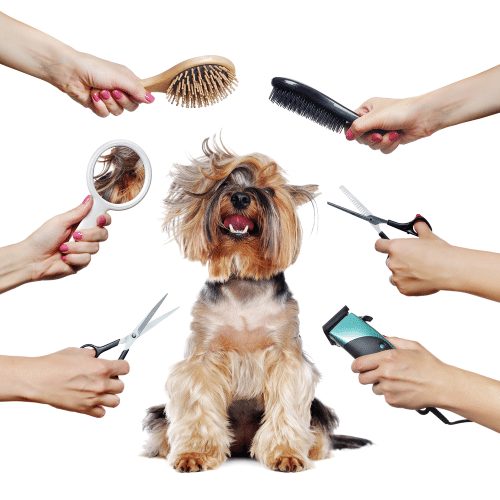On my 11th birthday, our family got a puppy. I was so chocked-I had wanted a dog for as long I could remember-and so overwhelmed with happiness that I burst into tears. For the next 15 years, Walter, a black toy poodle, charmed everyone he met. And when he passed, all of us who known him mourned, as would for any loved one. Did you know that half of American households have a pet? That is, an animal kept primarily for companionship. And despite the fact that these housemates may bear scales, fur, fins or feathers, people view their animals as family members. In 2014 we spent an estimates $58 billion on our animal companions and untold hours caring for them.

For 50 years psychologists have been trying unravel the appeals of animal companionship in hopes of deciphering just why we invest so much in these creatures. In the process, anthrozoologists-scientists who study human-animal relationships-have discovered a window into human sociability more broadly. Our interactions with animals can be useful models for understanding how issues of identity, nurturing, support and attachment play out in a relationship. “It’s all about human psychology,” says anthrozoologist Pauleen Bennet of La Troe University in Australia. “Pets help us fill our need for social connectedness.”
Although the motivations for pet ownership may vary as much as golden retriever and a goldfish, scientists are finding that some common threads tie people to their household pets. Our attraction to animals may be subconscious, driven by biological and social forces that we do not fully acknowledge. In addition, the emotional bond between pets and their owners can bring varied benefits, from lowered stress to novel adventures The more we uncover about our companion animals, the more we may learn about our human attachment as well.
Inborn Attraction?

Part of our attraction to animal companionship is innate. In 2013 psychologist Vanessa LoBue of Rutgers University and her colleagues revealed that toddlers one to three years old spend more time interacting with live animals-whether fish, hamsters, snakes, spiders or geckos-than they do with inanimate toys when given a choice between the two.
Humans even have specialized brain cells for recognizing animal life. Researchers led by Christof Koch of the Allen Institute for Brain Science in Seattle (he also serves on Scientific American Mind’s board of advisers) have found neurons in the amygdala, an area involved in emotions, that respond preferentially to animal images. The 2011 finding hints at a neural basis for the powerful emotional reactions animals elicit from us.
Many animals seem to tap into humans’ attraction to the adorable, a drive that also may motivate good parenting. Behavioral researchers have long noticed that humans seem to have inborn, positive responses to beings with characteristic typical of human infants-such as wide eyes, broad foreheads and large head to body ratios.
To better understand the responses that cuteness can elicit, psychologist Hiroshi Nittono and his colleagues at Hiroshima University in Japan published a series of experiments in 2012 in which college students, 132 in all, searched for a digit in numerical matrices of lifted tiny objects from small holes using tweezers. Afterward, participants viewed a series of photographs before attempting the attention or motor task for a second time.
Nittono and his colleagues found that students who viewed adult animals or food-stimuli they had rates as pleasant but not cute-did not improve between trials. But the students who saw cute baby animals did the tweezer task faster and more dexterously and performed the visual search task faster the second time, suggesting that being exposed to such creatures motivates focused, attentive behavior. This finding suggests that humans are primed to attend to fragile, young infants, who may require greater care than other beings. Clearly, baby animals exploit the same instinctive responses in us that human infants elicit.
Such findings lend credence to the idea that our interest in pets stems from what biologist E.O. Wilson has called “biophilia, or an inherent tendency to focus on life and lifelike processes. Our fascination with all manner of fauna might explain why people adopt such a wide range of animal life, from tarantulas to salamanders.
Yet Wilson has also acknowledged that our interest in animals depends on personal and cultural experience. For example, dogs are popular in many Western countries but are considered unclean in traditional Islamic communities. Indeed, psychologist Harold A. Herzog of Western Carolina University has argued that pet keeping is driven principally by culture. In a paper published in 2013 Herzog and his colleagues assessed the fluctuating popularity of dog breeds using the American Kennel Club’s registry from 1926 to 2005. They found no relationship between a breed’s healthy, longevity or behavioral traits such as aggressiveness or trainability and its popularity. Instead , they argued, the trends in top dogs were erratic and seemed to shift suddenly, as if driven by fashion. In 2014 three of the authors, including Herzog, further discovered that movies featuring specific dog breeds would boost the pooch’s popularity for up to a decade. In the 10 years following the 1963 release of the Incredible Journey, starring a Labrador retriever, people registered Labs in the kennel club at an average rate of 2,223 dogs a year, in contrast to 452 dogs a year in the previous decade.
Extending these findings to other species, Herzog posited that people may keep pets simply because other people keep pets, reflecting our penchant for imitation. He pointed to a brief craze in the U.S. for turtle keeping, a koi fish fad in Japan and what he jokingly identified as a brief “episodemic of Irish setters” as further evidence.
Friends with benefits
But even if imitations plays a role in their choices, most people profess to wanting pets for companionship. This friendship then sustains the connection despite the costs of ownership. Indeed, some animal human relationships feel similar in certain ways to human relationships. In a study published in 2014 Massachusetts General Hospital veterinarian Lori Palley and her colleagues used functional magnetic resonance imaging to measure brain activity in 14 mothers while they were looking at pictures of their children or their dogs or at picture of other people’s children or unfamiliar dogs. The researchers found that the brain activation patterns evoked by images of the women’s own children and dogs were very similar and that those patterns were distinct from those elicited by unknown children and canines, suggesting that maternal feelings may extend to animals Pets may thus help fill a human need to nurture other living beings.
An animal also can be on the flip side of this relationship, serving as a source of comfort. In the 1960s Yeshiva University psychologist Boris Levinson observed that trouble , socially withdrawn children became talkative and enthusiastic about therapy when his dog, Jingles, was present during a session. This observation spurred a series of investigations into whether or not keeping pets could improve well-being. IN a 1980 study of 9 people, biologist Erika Friedmann of the University of Pennsylvania reported that pet owners were more likely to be alive a year after a heart attack than were people who did not have a companion animal – possibly because animals afforded some form of stress relief. Yet efforts to replicate such findings have had mixed results, and animal assisted therapy, the field that Levinson’s work inspired, has been criticize for overstating the ability of animals to ameliorate mental illness. Nevertheless, some people may gain psychological support from their pets and keep them for exactly this reason. In a study published 2012 psychologist Sigal Zilcha-Mano, then at the Baruch Ivcher School of Psychology at the Interdisciplinary Center Herzlliya in Israel, and her colleagues asked 285 cat or dog owners to answer a questionnaire assessing their emotional connection with their pet. Then the researchers asked 120 of these pet owners to take a challenging word test. By recording her subjects’ blood pressure-a measure of stress-during the test, Zilcha-Mano found that individuals who had their pet present of thought about the pet before taking the test had lower stress than people who had no connection with the pet. In other words, the level of emotional sustenance a pet owner receives depends on how close he or she feels to the animal.
Different hormonal coctails seem to underpin various degrees of animal-human attachment. In a study published in 2012 biologist Linda Handlin of the University of Skovde in Sweden and her colleagues measured levels of the bonding hormone Oxycontin and stress hormone cortisol in 10 owners of female Labrador retrievers and correlated the results with self-reported data about the owner’s relationships with their dogs. Owners who had higher Oxycontin levels and lower cortisol levels when interacting with their dogs tended to have closer bonds with their pets. People who frequently kissed their dogs, for example, had higher levels of Oxycontin, and women who reported that they dreaded their dog’s death had lower cortisol levels, perhaps because they rely on their animals for stress relief.
A person’s social orientation could also factor into the strength of the pet-person tie. In a study published in 2012 psychologist Andrea Beetz of University of Rostock in Germany and her colleagues asked 47 -to 11-year-old boys who had difficulties forming social attachments to present a story before a committee of unfamiliar adults and then take a math test. During this ordeal, 24 of the children were accompanied by a dog, 10 had friendly human by their side and the others had a toy dog nearby.
Beetz found that children accompanied by a real dog had the lowest cortisol levels and that those with human company had the highest probably because people made these boys nervous. Furthermore, among those boys who benefited from the dog, those who engaged in the most petting and other physical contact with the dog during the test showed the least stress, as measured by salivary cortisol. Thus, interacting with animals may be an specially good buffer against stress for those who find human social interaction difficult. “Some things are much easier to forgive, don’t talk back, and there’s less inhibition when it comes to physical contact.”
Animal Antics
Yet pets are much more than human substitutes. Many people with no obvious social deficits reap varied psychological benefits from owning a pet. In 2012 Bennett presented preliminary findings from a student, psychologist Jordan Schaan, then at Monash University in Australia, who ha interviewed 37 dog owners who were personally and professionally successful and had an above average connection to animals. (The subjects were educated and affluent and had fulfilling romantic partnerships, for instance.) Among the benefits of dog ownership that these individuals reported were amusement-the animals’ antics made their owners laugh-a sense of meaning from having responsibility for the welfare of another living thing, and an entree into new experiences and relationships: a puppy can be a great way to met neighbors.
Furthermore, many pet owners described their companion animals as instructors in a simpler, more virtuous lifestyle. Bennett and Schaan discovered that their highly successful subjects actually looked to their dogs as role models for a better life. People felt they could derive unconditional love and forgiveness from their dogs, whereas human beings seemed more likely to disappoint one another. “There’s something about animals that’s very genuine and honest,” Bennett says. “We miss that in our human interactions.”
Bennett and other anthrozoologists acknowledge that owners project some of this dynamic onto their animals. An owner can ‘read’ a response into an animal companion’s behavior regardless of the animal’s intentions. Yet such projections are precisely what make this field ripe for psychology;they reveal our own social needs and desires. Animal relationships may someday provide useful comparison points to human connections-a benchmark for investigating empathy, caring and even decision making. That these creatures can fit many molds while being so different from us makes these friendships uniquely valuable.
The study of animal companionship is still in its infancy. But without this research, we could not begin to fathom the rich and varied range of relationships that make up human experience.
Source
Pets in the Family: An Evolutionary Perspective.
James A. Serpell and Elizabeth S. Paul in the Oxford Handbook of Evolutionary Family Psychology. Edited by Todd K. Shackelford and Catherine A. Salmon. Oxford University Press 2011
Biology, Culture, and the Origins of Pet-Keeping.
Harold A. Herzog in Animal Behavior and Cognition, Vol 1, No.3 pages 269-308; August 2014
Toward a Psychology of Human – Animal Relations.
Catherine E. Amiot and Brock Bastian in Psychological Bulletin, Vol 141, No. 1, pages 6-47; January 2015.











